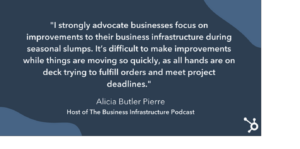Article written by Pamela Bump: Includes Quote from Alicia
Prepare when you can for business shifts.
” Alicia Butler Pierre, Host of the Business Infrastructure Podcast and CEO of Equilibria, Inc. says, “There are two major ways businesses can predict, diagnose, and/or prepare for a seasonal slump: resource planning and contingency planning.”
Contingency planning: This strategy — which often includes creating a premortem, failure modes and effects analysis (FMEA), and disaster recovery and business continuity plan –helps brands prepare for unexpected dips or upticks caused by outside factors like news events or national disasters.
Resource planning: “As your company utilizes different resources that serve as inputs into producing a good or delivering a service (outputs), you should collect data such as transaction dates, sale or invoice amounts, product or service type, and some customer demographic data.” says Butler Pierre. “If you notice the same patterns and trends year after year, you are in a better position to forecast and prepare for seasonal slumps. This, in turn, lets you know when to expand or contract inputs like labor and inventory.”
input process outputs flowchart showing how data should be involved in all planning phases

Data shows that a strong plan can be rewarding when business begins to pick up. In 2020, as consumers quickly turned to online stores for essentials, businesses that weren’t online were rushing to build online stores, while online stores were struggling to fulfill high-demand orders on time. Around this time, more than 50% of shoppers chose to buy products from brands with more product availability over brands they were originally loyal to.”

Source: https://blog.hubspot.com/marketing/summer-business-trends
